Snowdrops
by Diane - February 25th, 2013.Filed under: Crocus.
Snowdrops are one of the first signs that spring is on the way.
Treat yourself to them – they are planted in the green – when they still have leaves. This is unlike most bulbs that are planted just as bulbs.
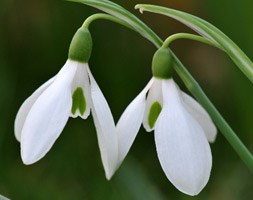
Galanthus nivalis (common snowdrop bulbs) £2.49
Position:sun or partial shade Soil: humus-rich, moist but well drained soil Rate of growth: average Flowering period: January and February Flower colour: white Other features: all parts of the plant may cause a mild stomach upset if ingested; contact with the bulbs may cause skin irritation Hardiness: fully hardy Bulb size: 4/5 It’s hard not to love these wonderful bulbs for adding colour to the garden when little else is awake. The nodding white flowers have a small green marking on the inside of each tepal, are honey scented, and appear in late winter. They look particularly good planted in large drifts in grass where they will naturalise quite happily. Alternatively plant them up in clumps in the front of mixed borders, or into pots so they can be admired close up. Garden care: Plant bulbs 5cm deep in dense clusters to form naturalistic drifts. Where bulbs are planted in grass do not cut the grass until after the leaves have died right back. Divide large colonies after flowering while the leaves are still green for use in other moist, well-drained areas.
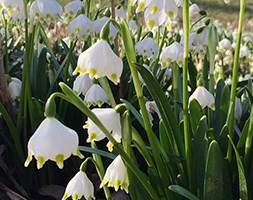
Leucojum vernum (Spring snowflake bulbs) £4.99
Position: full sun Soil: reliably moist but well-drained soil Rate of growth: average Flowering period: March to April Flower colour: white with green tips Hardiness: fully hardy Nodding, bell-shaped, white flowers, each with green tips, top upright stems in early spring. Closely related to the snowdrop, this is a later-flowering, taller option that looks wonderful when naturalised in bold drifts throughout a lawn, or allowed to clump up in pockets towards the front of the border. They prefer reliably moist (but not waterlogged) soils, so are ideal for planting on the upper banks of a pond. Garden care: Plant bulbs in autumn 10cm deep and 8 – 10 apart. Allow the plant to die back completely before clearing away the foliage.
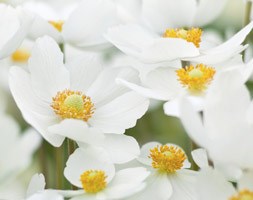
Anemone sylvestris (snowdrop anemony, snowdrop windflower) £7.99
Position: full sun or partial shade Soil: moist but well drained, humus-rich soil. Likes neutral or alkaline soils Rate of growth: fast Flowering period: April – May Hardiness: fully hardy A lovely little anemone which forms a mound of deeply cut foliage, topped with nodding white flowers with yellow centres in late spring. The plant gets its common name from the way the flower buds emerge on bent stems, so they hang like snowdrops. Then they straighten up and face outwards as the flowers start to open. The petals catch the breeze, making them look a little like butterflies, and they will grow to form open cup shapes up to 7cm across. They are scented and are good for cutting, but if you leave them on, they will be followed by white woolly seedheads. Find the right spot for them and they will naturalise and spread into large clumps. Garden care: Apply a generous 5-7cm mulch of well-rotted garden compost or manure around the base of the plant in spring. Cut back to just above ground level if they start to look messy and they will quickly rejuvenate. Where necessary, lift and divide congested clumps in early spring.
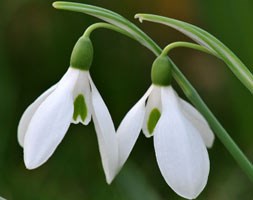
Galanthus nivalis (snowdrop – In The Green) £7.99
Position:partial shade Soil: humus-rich, moisture-retentive soil Rate of growth: fast-growing Flowering period: January and February Flower colour: pure white Other features: all parts of the plant may cause a mild stomach upset if ingested; contact with the bulbs may cause skin irritation Hardiness: fully hardy Snowdrop bulbs bought in the autumn tend to get dehydrated and this can lead to disappointing results. This is why planting bulbs ‘in the green’ is becoming more and more popular. Snowdrops are perfect for naturalising in grass. Plant in well-drained, moisture-retentive soil. Garden care: Plant in naturalistic drifts when they arrive. Where bulbs are planted in grass do not cut the grass until after the leaves have died back. Divide large colonies immediately after flowering while the leaves are still green.
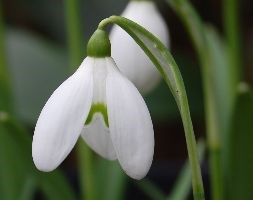
Galanthus ‘S. Arnott’ (snowdrop bulbs) £9.99
Position: cool, partial shade Soil: moderately-fertile, moist but well-drained alkaline to neutral soil. Snowdrops dislike acid soils. Rate of growth: average Flowering period: February-March Flower colour: white with green ‘V’ shaped markings Other Features: flowers cut well for an early posy Hardiness: fully hardy A rare, relatively large and vigorous form, named after Samuel Arnott (born in Dumfries in 1852) who was a keen gardener and snowdrop offocinado. He first discovered this in his garden and later introduced it into cultivation. Like a pumped-up version of the common snowdrop, this super-sized version has deliciously honey-scented flowers. Garden care: Plants will seed readily, but tend to hybridise. Lift and divide overly-large clumps while they are ‘in the green’ every 2-3 years after flowering from March to May. Replant immediately and water in well.
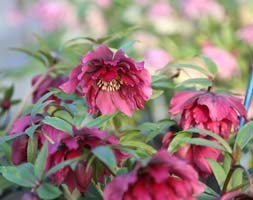
Helleborus x hybridus Harvington double red (Lenten rose hellebore) £9.99
Position: partial shade Soil: heavy, neutral to alkaline soil Rate of growth: average Flowering period: February to April Other features: all parts of the plant cause severe discomfort if ingested; the sap may cause skin irritation; dark greyish-green leaves give off an unpleasant odour when crushed Hardiness: fully hardy Red petals form bowl-shaped flowers, each with a prominent boss of golden stamens, in late winter. Plant with spring flowering bulbs like snowdrops or crocus, beneath a canopy of deciduous shrubs or trees for early interest. Garden care: Add lots of well-rotted leaf mould or organic matter to the planting hole. Cut the old leaves back down to the ground in January or February as this will show off the new emerging flowers to best effect. It will also help to get rid of foliar diseases such as Hellebore leaf spot. Apply a generous 5-7cm (2-3in) mulch of well-rotted organic matter around the base of the plant in autumn and provide a top-dressing of general fertiliser each spring.
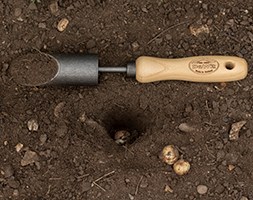
De Wit hand crocus / snowdrop bulb planter £9.99
This bulb planter has been a best seller for us. It is perfect for planting small bulbs, such as Crocus, Snowdrops and Crocosmias as it makes holes that are just big enough for the bulb so you don’t get great big holes in the lawn or border. Every De Wit garden tool is handmade in Holland; hand-forged from solid, top quality steel, shaped, sharpened and finally fitted with an oiled, solid ash wood handle of the finest quality. The Dutch are rightly regarded as makers of the finest gardening tools. De Wit have been around longer than anyone. They started in 1898 and the 4th generation of De Wits are now in charge of the business; one is a trained wood turner, the other trained as a blacksmith. De Wit forge their tools from carbon steel in the traditional way. Carbon Steel is naturally tougher than stainless steel and is not prone to metal fatigue. De Wit also burnish their steel. This not only helps to protect it for longer but gives it a patina that blackens it – just like traditional English tools from the Edwardian era. All De Wit tools have turned hardwood handles of oiled Ash. Ash is not only very strong but resists shock better than woods like oak or beech, which is why it was traditionally used for Axe handles. Size Head: 11.5cm long x 4cm wide ( 4.5 x 1.5) Total Length: 18.8cm long (10.5)

De Wit long handled crocus / snowdrop bulb planter £16.99
This bulb planter is perfect for planting small bulbs, such as Crocus, Snowdrops and Crocosmias. Every De Wit garden tool is handmade in Holland; hand-forged from solid, top quality steel, shaped, sharpened and finally fitted with an oiled, solid ash wood handle of the finest quality. The Dutch are rightly regarded as makers of the finest gardening tools. De Wit have been around longer than anyone. They started in 1898 and the 4th generation of De Wits are now in charge of the business; one is a trained wood turner, the other trained as a blacksmith. De Wit forge their tools from carbon steel in the traditional way. Carbon Steel is naturally tougher than stainless steel and is not prone to metal fatigue. De Wit also burnish their steel. This not only helps to protect it for longer but gives it a patina that blackens it – just like traditional English tools from the Edwardian era. All De Wit tools have turned hardwood handles of oiled Ash. Ash is not only very strong but resists shock better than woods like oak or beech, which is why it was traditionally used for Axe handles. The result is a beautiful tool to hold in the hand but rugged and durable. They feel so natural to use that they are like an extension of the person that uses them. These tools will give you a lifetime of use, until you hand them on. Size Head: 10cm long x 4cm wide Total Length: 89cm long (890mm)






